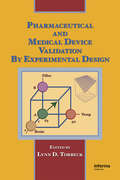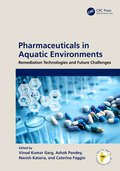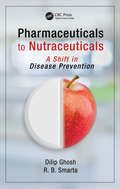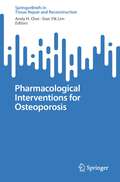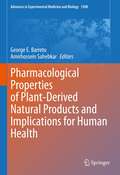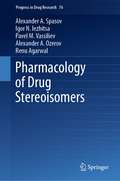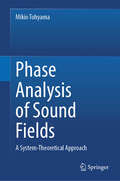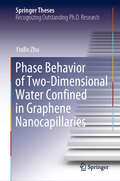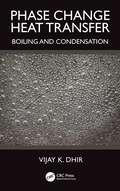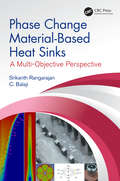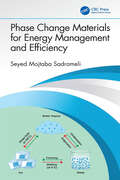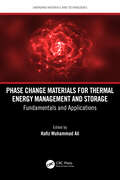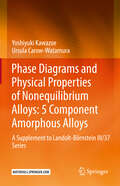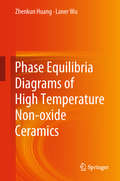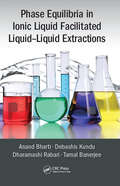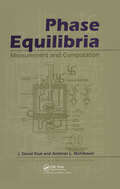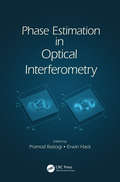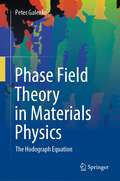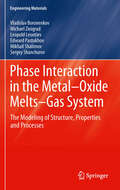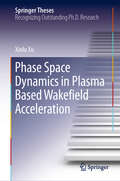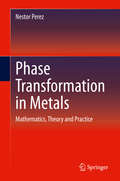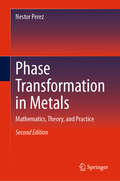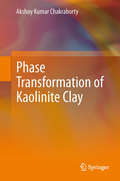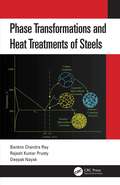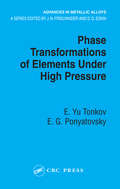- Table View
- List View
Pharmaceutical and Medical Device Validation by Experimental Design
by Lynn D. TorbeckThis title demonstrates how designed experiments are the most scientific, efficient, and cost effective method of data collection for validation in a laboratory setting. Intended as a learn-by-example guide, Pharmaceutical and Medical Device Validation by Experimental Design demonstrates why designed experiments are the most logical and rational ap
Pharmaceuticals in Aquatic Environments: Remediation Technologies and Future Challenges
by Ashok Pandey Vinod Kumar Garg Navish Kataria Caterina FaggioThis book covers pharmaceutical residue dispersion in the aquatic environment and its toxic effect on living organisms. It discusses conventional and advanced remediation technologies such as the use of biomaterials for the sequestration of contaminants, nanotechnology, and phytoremediation. The book includes topics such as the removal of pharmaceutical and personal care product residues from water bodies, green chemistry, and legal regimens for pharmaceuticals in the aquatic environment. It also covers the application of modified biochar in pharmaceutical removal.FEATURES Explores the management of the environment through green chemistry Describes phytoremediation technology for decontamination of pharmaceutical-laden water and wastewater Covers the detection methods and quantification of pharmaceutical residues in various contaminated sources Discusses ecotoxicological aspects and risk assessment of pharmaceuticals in the aquatic environment Reviews degradation and treatment technologies including nanotechnology, biomaterials, and biochar This book is meant for pharmaceutical, toxicology, and environmental science industry experts and researchers.
Pharmaceuticals to Nutraceuticals: A Shift in Disease Prevention
by Dilip Ghosh R. B. SmartaRecently, there has been a fundamental shift in the global health and wellness industry from disease treatment to preventing chronic diseases. The use of nutraceuticals and functional foods in prevention efforts could lead to a decreased dependency on drugs. The pharmaceutical industry recognizes this shift; however, serious concerns have arisen regarding the claimed efficacy, quality, and safety of products used as medical foods. This book examines the consumer and industry mindshift, including the scientific evidence of these foods as effective adjuncts to pharmacotherapy during all stages of treatment of various diseases, thus indicating that pharmaceuticals and nutraceuticals can and should coexist. It details quality, safety, and efficacy of foods, drugs, and nutrients; marketing and product positioning; regulatory perspectives; biomarkers and metabolites; probiotics; food/drug interactions; and future industry trends. In addition, food bioactives represent diet-based molecules that perform physiological roles related to disease prevention and treatment. As such, a considerable overlap exists between food bioactives and drugs—this book presents the case for comparing and contrasting foods versus drugs in several models of health and disease.
Pharmacological Interventions for Osteoporosis (Tissue Repair and Reconstruction)
by Andy H. Choi Sian Yik LimThis book provides readers a fundamental insight into the basic properties of the pharmaceutical agents used in the treatment of osteoporosis. It provides insight into mechanisms of action, updated information on clinical utility, and possible side effects associated with the use of these pharmaceutical agents. In particular, it highlights the use of two monoclonal antibodies romosozumab and denosumab in activating osteoblast differentiation and inhibiting osteoclasts. It also discusses two anabolic pharmaceutical agents, teriparatide and abaloparatide to treat osteoporosis. They have been shown to reduce the incidence of non-vertebral and vertebral fractures significantly after they were administered to patients daily as subcutaneous injections. The content of this book caters to researchers, scientists, and clinical practitioners who are interested in the treatment of osteoporosis using pharmaceutical agents.
Pharmacological Properties of Plant-Derived Natural Products and Implications for Human Health (Advances in Experimental Medicine and Biology #1308)
by George E. Barreto Amirhossein SahebkarMedicinal plants and their derived products remain as an indispensable source of bioactive molecules that serve as either drug candidates or lead compounds for drug design and discovery. There are several advantages for plant-derived therapeutics including wide availability, diverse pharmacological actions and a generally good profile of safety and tolerability. Over the recent years, there have been numerous reports from clinical studies testifying to the efficacy and safety of medicinal plants and phytochemicals in ameliorating several human diseases. A plethora of basic studies has also unravelled molecular mechanisms underlying the health benefits of herbal medicines. Nevertheless, issues such as identification of bioactive ingredients, standardization of the products and drug interactions remain to be further studied. In this book, we aim to put together several chapters on the medicinal properties and pharmacological action of medicinal plants, plant species and phytochemicals. The goal is to present a comprehensive collection on most of the therapeutic aspects of plant-derived natural products and molecular mechanisms thereof.
Pharmacology of Drug Stereoisomers (Progress in Drug Research #76)
by Renu Agarwal Alexander A. Spasov Igor N. Iezhitsa Pavel M. Vassiliev Alexander A. OzerovThe book is devoted to an important aspect of pharmacology and pharmaceutical chemistry, i.e. the significance of stereoisomerism of drugs for their biological effect from the point of view of their pharmacokinetics, pharmacodynamics and toxicology. The authors review the landmarks in the development of stereochemistry and stereopharmacology. Present-day IUPAC terminology is discussed; general issues of stereoisomerism are considered including separation of racemic mixtures and asymmetric synthesis of isomers, methods of quantifying the isomers of a drug in biological material. The authors put special emphasis on general problems of the influence of stereoisomerism on pharmacological and adverse effects of drugs. A classification of drugs based on stereochemical properties of their isomers is proposed. Possibilities of interaction of stereoisomers in racemic mixtures are discussed. A considerable portion of the book is devoted to pharmacological action of the main groups of drugs whose structure includes asymmetric atoms (that is, drugs with several isomers). Detailed attention is paid to advisability of developing single isomer drugs and to the specifics of their study at the stage of preclinical and clinical trials.
Phase Analysis of Sound Fields: A System-Theoretical Approach
by Mikio TohyamaThis book deals with the phase properties in the context such as sound fields in rooms from a perspective of transfer functions for sound paths. Phase analysis, i.e., investigations of zeros of transfer functions, is a qualitative or system theoretic approach to sound fields rather than the wave-theoretic power spectral analysis. The examination of phase responses offers new insights into sound fields and yields results that the standard power spectral analysis cannot provide. This book presents experimental data and numerical examples based on the mathematical formulations. It shows the mathematical formulations of acoustics and communication systems for engineers and physicists to get familiar with the basics of science. Chapters 1–5 provide the theoretical basis on the system theoretic approach to sound fields where Chapters 1 and 2 are introductions to discrete acoustic systems, Chapters 3–5 summarize wave equations, geometrical and random theories of room acoustics, and Chapters 6–10 develop details of transfer functions in sound.
Phase Behavior of Two-Dimensional Water Confined in Graphene Nanocapillaries (Springer Theses)
by YinBo ZhuIn this book, the authors use molecular dynamics simulations to conduct a comprehensive study of the compression/superheating limit and phase transition of 2D (monolayer, bilayer, and trilayer) water/ice constrained in graphene nanocapillaries. When subjected to nanoscale confinement and under ultrahigh pressure, water and ice behave quite differently than their bulk counterparts, partly because the van der Waals pressure can spark a water-to-ice transformation, known as the metastability limit of two-dimensional (2D) liquids. From a mechanical standpoint, this liquid-to-solid transformation characterizes the compression limit (or metastability limit) of 2D water. The findings presented here could help us to better understand the phase behavior of 2D confined water/ice.
Phase Change Heat Transfer: Boiling and Condensation
by Vijay K. DhirPhase Change Heat Transfer covers theory and experiments in heat transfer associated with boiling and condensation. It presents the basics of solid–liquid–vapor phase interactions and methods to measure surface wettability and interfacial tension between liquid and vapor.Exploring the mechanistic details of pool boiling heat transfer, this book gives correlations for the prediction of nucleate boiling, critical heat flux, and post-critical heat flux. It describes and analyzes homogeneous nucleation and heterogeneous nucleation. This book also discusses both film and dropwise condensation including integral and differential solutions for laminar film condensation. The book also includes flow boiling and numerical simulations of pool boiling. This book is intended for upper-level undergraduate mechanical, aerospace, nuclear, and chemical engineering students taking courses in Phase Change Heat Transfer, Boiling and Condensation, Nuclear Thermal Hydraulics, and Advanced Heat and Mass Transfer.Instructors will be able to utilize a Solutions Manual and Figure Slides for their course.
Phase Change Material-Based Heat Sinks: A Multi-Objective Perspective
by Srikanth Rangarajan C. BalajiPhase-change Material based heat sinks and associated optimization remains a topic of great interest, as evident from the increasing number of citations and new applications and miniaturization. Often the multi objective perspective of such heat sinks is ignored. This book introduces the readers to the PCM based heat sinks and Multi objective optimization. The authors have also included interesting in house experimental results on the "Rotating heat sinks" which is a first of a kind work. Useful to budding thermal researchers and practicing engineers in the field, this book is also a great start for students to understand the cooling applications in electronics and an asset to every library in a technical university. Since this book not only gives a critical review of the state of the art but also presents the authors' own results. The book will encourage, motivate and let the reader consider pursuing a research career in electronic cooling technologies.
Phase Change Materials for Energy Management and Efficiency
by Seyed Mojtaba SadrameliThis book explores the prospective applications of Phase Change Materials (PCMs) in energy storage systems, thermal system temperature control, peak shifting, and energy management. It starts with definitions and a brief history of energy storage systems, followed by an exploration of different types of PCMs, encapsulation techniques, heat transfer enhancement methods, and the applications and challenges of PCMs. The book provides a comprehensive overview of PCM applications in building envelopes, free cooling, electrical appliances, lithium-ion batteries, textiles, solar panels, vehicles and logistics, and more across 14 chapters.• Demonstrates various techniques for the enhancement of energy storage systems.• Offers an applied approach.• Discusses energy management, thermal control, peak shifting, energy conservation, and energy storage.Aimed at researchers in industrial manufacturing sectors, it can also serve as a resource for undergraduate and graduate students in energy management courses. In addition, this reference is valuable for engineers and scientists focused on energy optimization and the application of sustainable materials.
Phase Change Materials for Thermal Energy Management and Storage: Fundamentals and Applications (Emerging Materials and Technologies)
by Hafiz Muhammad AliPhase Change Materials for Thermal Energy Management and Storage: Fundamentals and Applications provides the latest advances in thermal energy applications of phase change materials (PCMs). It introduces definitions and offers a brief history, and then delves into preparation techniques, thermophysical properties and heat transfer characteristics with mathematical models, performance-affecting factors, and applications and challenges of PCMs.Features Provides key heat transfer enhancement and thermophysical properties features for a wide range of PCMs. Presents detailed parameter selection procedures impacting heat transfer. Reviews available prediction methods for heat transfer and thermophysical properties of PCMs. Discusses practical applications for enhanced thermal control. Explores challenges and potential opportunities for heat transfer enhancement. This reference offers a comprehensive overview of the fundamentals, technologies, and current and near-future applications of PCMs for thermal energy management and storage for researchers and advanced students in materials, mechanical, and related fields of engineering.
Phase Diagrams and Physical Properties of Nonequilibrium Alloys: A Supplement to Landolt-Börnstein III/37 Series
by Yoshiyuki Kawazoe Ursula Carow-WatamuraThis handbook presents the data of 5-component metallic amorphous alloys, including a large number of specimen obtained by adding a 5-th component to a quaternary alloy, some were obtained by starting from lower component base alloys, and there are a few examples of so-called high-entropy alloys.It contributes both to fundamental researches and industrial applications.
Phase Equilibria Diagrams of High Temperature Non-oxide Ceramics
by Zhenkun Huang Laner WuThis book explores new experimental phase diagrams of non-oxide ceramics, with a particular focus on the silicon nitride, silicon carbide and aluminum nitride, as well as the ultra-high temperature ceramic (UHTC) systems. It features more than 80 experimental phase diagrams of these non-oxide ceramics, including three phase diagrams of UHTC systems, constructed by the authors. Physical chemistry data covering the period since the 1970s, collected by the author Z.K.Huang, is presented in six tables in the appendixes. It also includes 301 figures involving about 150 material systems. Most of the phase diagrams have been selected from the ACerS-NIST database with copyright permission. The book methodically presents numerous diagrams previously scattered in various journals and conferences worldwide. Providing extensive experimental data, it is a valuable reference resource on ceramics development and design for academic researchers, R&D engineers and graduate students.
Phase Equilibria in Ionic Liquid Facilitated Liquid-Liquid Extractions
by Anand Bharti Debashis Kundu Dharamashi Rabari Tamal BanerjeeThis book provides a comprehensive overview of ionic liquid based separation techniques. The glimpse of thermodynamic predictive models along with global optimization techniques will help readers understand the separation techniques at molecular and macroscopic levels. Experimental and characterization techniques are coupled with model based predictions so as to provide multicomponent data for the scientific community. The models will focus more on the a-priori based predictions which gives higher emphasis on hydrogen-bonded systems. Particle Swarm Optimization (PSO) technique will also eventually help the readers to apply optimization technique to an extraction process. The overriding goal of this work is to provide pathways for leading engineers and researchers toward a clear understanding and firm grasp of the phase equilibria of Ionic Liquid systems.
Phase Equilibria: Measurement & Computation
by Andreas L. Muhlbauer J. David RaalThis work provides coverage of experimental and theoretical procedures for vapour-liquid equilibria (VLE). A survey of the different models and approaches in recent literature enables the reader to choose the appropriate action.
Phase Estimation in Optical Interferometry
by Pramod Rastogi Erwin HackThis book covers the essentials of phase-stepping algorithms used in interferometry and pseudointerferometric techniques. It presents the basic concepts and mathematics needed for understanding modern phase estimation methods. The book first focuses on phase retrieval from image transforms using a single frame. It then examines the local environment of a fringe pattern, the phase estimation approach based on local polynomial phase modeling, temporal high-resolution phase evaluation methods, and methods of phase unwrapping. It also discusses experimental imperfections liable to adversely influence the accuracy of phase measurements.
Phase Field Theory in Materials Physics: The Hodograph Equation
by Peter GalenkoThis book deals with the use of the hodograph equation in phase transformations in condensed matter, especially, for crystallization and solidification processes. The main focus of the book is the interpretation of the phase-field equations for isotropic and anisotropic interfaces based on the advanced Gibbs–Thomson and Herring conditions, respectively. Beginning with the basic ideas behind the extended irreversible thermodynamics, the kinetic phase-field model for slow and arbitrarily fast phase transformations is derived where the unified hodograph equation follows from:• the sharp interface limit of the diffuse interface or• the traveling wave solution of the propagating phase field.Under the example of solute trapping and disorder trapping effects, comparing theoretical results with molecular dynamics simulations, and with the analysis of experimental data, the concrete workability of the developed hodograph equation is demonstrated for widest range of driving force in phase transformations.
Phase Interaction in the Metal - Oxide Melts - Gas -System
by Mikhail Shalimov Michael Zinigrad Vladislav Boronenkov Edward Pastukhov Leopold Leontiev Sergey ShanchurovThis monograph describes mathematical models that enable prediction of phase compositions for various technological processes, as developed on the base of a complex physico-chemical analysis of reaction. It studies thermodynamics and kinetics of specific stages of complex pyrometallurgical processes involving boron, carbon, sulfur, tungsten, phosphorus, and many more, as well as their exposure to all sorts of factors. First and foremost, this enables to optimize processes and technologies at the stage of design, while traditional empirical means of development of new technologies are basically incapable of providing an optimal solution. Simulation results of metals and alloys production, welding and coating technologies allow obtaining materials with pre-given composition, structure and properties in a cost-saving and conscious manner. Moreover, a so-called "inverse problem", i.e., selecting source materials which would ensure the required results, cannot be solved by any other means.
Phase Space Dynamics in Plasma Based Wakefield Acceleration (Springer Theses)
by Xinlu XuThis book explores several key issues in beam phase space dynamics in plasma-based wakefield accelerators. It reveals the phase space dynamics of ionization-based injection methods by identifying two key phase mixing processes. Subsequently, the book proposes a two-color laser ionization injection scheme for generating high-quality beams, and assesses it using particle-in-cell (PIC) simulations. To eliminate emittance growth when the beam propagates between plasma accelerators and traditional accelerator components, a method using longitudinally tailored plasma structures as phase space matching components is proposed. Based on the aspects above, a preliminary design study on X-ray free-electron lasers driven by plasma accelerators is presented. Lastly, an important type of numerical noise—the numerical Cherenkov instabilities in particle-in-cell codes—is systematically studied.
Phase Transformation in Metals: Mathematics, Theory and Practice
by Nestor PerezThis textbook explains the physics of phase transformation and associated constraints from a metallurgical or materials science point of view, based on many topics including crystallography, mass transport by diffusion, thermodynamics, heat transfer and related temperature gradients, thermal deformation, and even fracture mechanics. The work presented emphasizes solidification and related analytical models based on heat transfer. This corresponds with the most fundamental physical event of continuous evolution of latent heat of fusion for directional or non-directional liquid-to-solid phase transformation at a specific interface with a certain geometrical shape, such as planar or curved front. Dr. Perez introduces mathematical and engineering approximation schemes for describing the phase transformation, mainly during solidification of pure metals and alloys. Giving clear definitions and explanations of theoretical concepts and full detail of derivation of formulae, this interdisciplinary volume is ideal for graduate and upper-level undergraduate students in applied science, and professionals in the metal making and surface reconstruction industries.
Phase Transformation in Metals: Mathematics, Theory, and Practice
by Nestor PerezThis new edition retains its class-tested explanation of the physics of phase transformation and associated constraints from a metallurgical/materials science point of view, and adds an enhanced treatment of the underlying theoretical concepts with greater clarification. The new edition continues its examination of crystallography, mass transport by diffusion, thermodynamics, heat transfer and related temperature gradients, thermal deformation, and even fracture mechanics. The work presented emphasizes solidification and related analytical models based on heat transfer. This corresponds with the most fundamental physical event of continuous evolution of latent heat of fusion for directional or non-directional liquid-to-solid phase transformation at a specific interface with a certain geometrical shape, such as planar or curved front. Dr. Perez introduces mathematical and engineering approximation schemes for describing the phase transformation, mainly during solidification of pure metals and alloys. Giving clear definitions and explanations of theoretical concepts and full detail of derivation of formulae, this interdisciplinary volume is ideal for graduate and upper-level undergraduate students in applied science, and professionals in the metal making and surface reconstruction industries.
Phase Transformation of Kaolinite Clay
by Akshoy Kumar ChakrabortyThe book depicts comprehensive studies on thermal decomposition of Kaolinite by different physico-chemical methods carried out by various scientists in last 100 years and results of the studies conducted by author in past 33 years. It also provides a critical analysis of different views on Kaolinite-Mullite reaction series, characterization of controversial spinel phase in Kaolinite-Mullite reaction series and explanation of DTA events of Kaolinite. The book helps both researchers and students to realise the new mechanism of transformation of Kaolinite to Mullite. The new reaction processes discussed in the book also help ceramic experts to synthesize Mullite grains in commercial way for production of Mullite porcelain and Mullite refractory.
Phase Transformations and Heat Treatments of Steels
by Bankim Chandra Ray Rajesh Kumar Prusty Deepak NayakThe perpetual flow of understanding between phase transformation that controls grain/microstructures and heat treatment which decides the size of grains/microstructures of steels is not well articulated in the perspective of undergraduate students. In Phase Transformations and Heat Treatments of Steels, theories of phase transformation have been used to obtain a desirable phase or combination of phases by performing appropriate heat treatment operations, leading to unification of both the concepts. Further, it includes special and critical heat treatment practices, case studies, local and in-service heat treatments, curative and preventive measures of heat treatment defects for several common and high-performance applications. Features: Presents fundamentals of phase transformation in steels Analyzes basics of phase transformation due to heat treatment of steel under various environmental conditions Explains application of heat treatment for different structural components Discusses heat treatment defects and detection Emphasizes heat treatment of special steels and in-situ heat treatment practices
Phase Transformations of Elements Under High Pressure (Advances in Metallic Alloys)
by E. Yu Tonkov E.G. PonyatovskyAs laboratories replace heavy hydraulic presses and bulky high-pressure chambers with miniature diamond anvils, traditional heaters with laser heating, and continue to improve methods of shock compression, there has been considerable new data obtained from the high-pressure, high-temperature modification of pure elements. The dense metallic modification of elements shows the potential for achieving superconductivity akin to theoretical predictions.Phase Transformations of Elements Under High Pressure contains the latest theoretical and experimental information on nearly 100 elements, including first-and second-phase transitions, melting lines, crystal structures of stable and metastable phases, stability of polymorphic modifications, and other useful properties and data. It emphasizes features such as changes in the liquid state, amorphization, and metallization, and provides temperature-pressure diagrams for every element. The book also describes the transitions of polymeric forms of fullerene, crystal modifications of elements stable under high pressures, and provides data that confirms their superconducting and magnetic properties.This handbook will be a lasting reference for scientists in a broad range of disciplines, including solid-state physics, chemistry, crystallography, mineralogy, and materials science.
